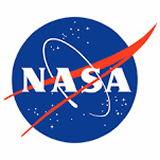
- For other uses, see NASA (disambiguation)NASA (disambiguation)NASA or Nasa may refer to:* NASA, National Aeronautics and Space Administration* National Association of Students of Architecture, India* National Auto Sport Association* North America and South America...
. For news about NASA, see Wikinews space portal or Unmanned NASA missionsUnmanned NASA missionsFollowing is a sampling of some of NASA's past and present programs excluding manned spacecrafts. The years in brackets are for first and latest launching. A program is a number of flights or missions with the same kind of satellite therefore the name of the program and the name of the satellite...
(satellites).
The National Aeronautics and Space Administration (NASA) is the agency of the United States government
that is responsible for the nation's civilian space program and for aeronautics
and aerospace
research. Since February 2006, NASA's mission statement has been to "pioneer the future in space exploration
, scientific discovery
and aeronautics research." On September 14, 2011, NASA announced that it had selected the design of a new Space Launch System
that it said would take the agency's astronauts farther into space than ever before and provide the cornerstone for future human space exploration efforts by the U.S.
NASA was established by the National Aeronautics and Space Act
on July 29, 1958, replacing its predecessor, the National Advisory Committee for Aeronautics
(NACA).
1915 NACA, the predecessor of NASA, is founded.
1958 U.S. President Dwight D. Eisenhower signs into law the National Aeronautics and Space Act, which creates the National Aeronautics and Space Administration (NASA).
1958 NASA is created to replace NACA.
1958 Pioneer program: NASA launches the lunar probe Pioneer 1 (the probe falls back to Earth and burns up).
1959 Project Mercury: NASA announces the selection of the United States' first seven astronauts, whom the news media quickly dub the "Mercury Seven".
1959 President Dwight D. Eisenhower signs an executive order transferring Wernher von Braun and other German scientists from the United States Army to NASA.
1960 In Huntsville, Alabama, US President Dwight D. Eisenhower formally dedicates the Marshall Space Flight Center (NASA had already activated the facility on July 1).
1961 NASA launches the first Saturn I rocket in Mission Saturn-Apollo 1.
1962 Apollo Project: NASA announces plans to build the C-5 rocket booster. It became better known as the Saturn V moon rocket, which launched every Apollo moon mission.
1962 NASA's Ranger 4 spacecraft crashes into the Moon.
For the benefit of all.![]()
To improve life here. To extend life to there. To find life beyond.![]()
To understand and protect our home planet, To explore the universe and search for life, To inspire the next generation of explorers.![]()
Shaping the Future: Launching New Endeavors to Inspire the Next Generation of Explorers.![]()
NASA, the National Aeronautics and Space Administration. Where else but in Texas would men set up to administer space?![]()

